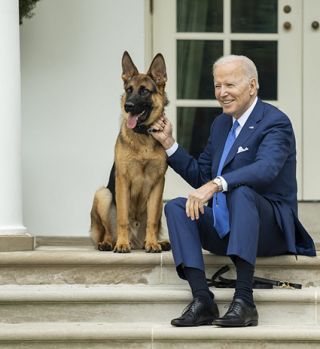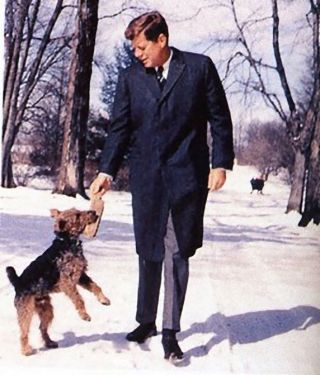Animal Behavior
When the President's Dog Misbehaves
A number of US presidents have been distressed by troublesome family dogs.
Posted February 28, 2024 Reviewed by Lybi Ma
Key points
- Aggression is one of the top three reasons why people relinquish pet dogs to shelters.
- Recent reports indicate that President Biden's dog Commander has bitten a number of Secret Service agents.
- Both John F. Kennedy and Ronald Reagan had dogs that bit White House staff or even the president himself.
- Theodore Roosevelt and Calvin Coolidge had nippy dogs which caused embarrassing incidents in the White House.

Joe Biden's German Shepherd, Commander, has been a bad dog — a very bad dog. According to CNN investigative reporters Camila DeChalus and Betsy Klein, who reviewed more than 400 pages of official documents, Commander has bitten US Secret Service personnel in at least 24 incidents. Some of these were serious enough to draw blood and require stitches. That number does not appear to include additional incidents involving other White House staff and workers.
Not all dogs work out well for the families who adopt them. I was surprised to learn, from a series of scientific surveys in North America and Britain that up to four out of every ten puppies do not successfully make it through the first year with the people who first adopt them. These dogs are returned to their breeders, or given up to shelters, killed by their owners, taken to a veterinarian to be euthanized, or simply abandoned. The most common reasons for relinquishing these dogs are behavioral issues, and aggression shows up as one of the top three causes in numerous studies.
However, there seems to be a popular expectation that the dogs that occupy the White House, especially the family dogs of the president, should be civilized, decorous, calm, and well-behaved as befits the status held by their presidential owners. However, there is a long history of delinquent tendencies in the dogs kept by First Families in the U.S.

JFK and Charlie
When John F. Kennedy was elected president, he had a Welsh Terrier named Charlie. Typical of terriers, Charlie was bossy and self-assured. He developed a trick that did not endear him to the gardeners and workers outside around the White House. He would silently slip up behind a worker who was digging or working the soil. He would then make a quick rush at the man, nipping him in the seat of the pants or grabbing at his leg. The attack was over in seconds and Charlie quickly scampered away. One worker complained to his supervisor that Charlie had bitten hard enough to draw blood. The worker was told to accept the behavior. Otherwise, he would be asked to leave his job, not the dog.
Teddy Roosevelt and Pete
Theodore Roosevelt’s Bull Terrier, Pete, also had a dominant terrier personality, and if people annoyed him he had no hesitation about responding with his teeth. When he nipped at a naval officer and snapped at some cabinet ministers, Roosevelt waved the incidents off as “the nature of the breed” or “his attitudes toward their political stances.” Unfortunately, one day the French ambassador, Jules Jusserand, arrived at the White House wearing a morning coat with tails (like a tuxedo). The dangling of tails was too much for Pete who leaped up to snap at them and ended up tearing the bottom out of his pants instead. The press made a large fuss about this, the French government complained, and rather than jeopardize U.S. relations with France, Pete was exiled to the Roosevelt mansion at Sagamore Hill.
Calvin Coolidge and Peter Pan
Dangling clothing can trigger the prey drive in many terriers, as Calvin Coolidge unfortunately learned. He owned a wirehaired Fox Terrier, named Peter Pan. The dog was untrained and often became uncontrollably excited around visitors and White House staff members. Coolidge thought that this was rather amusing, and would sometimes warn visitors about his nipping by saying "Be careful, Peter is one Republican in the White House who bites." One hot summer day some visitors arrived, including a woman who was wearing a long skirt made out of some very light material, appropriate for warm weather. It had a flowery print and was cinched with a cord-like belt with tassels that hung down in the back. The president greeted her out on the White House lawn, and as the woman turned either the swishing of the skirt or the bouncing of the tassels caught Peter Pan's attention. He immediately leaped at her skirt, catching some of the flimsy material in his teeth. There was a tearing sound, and the skirt seemed to disintegrate leaving the poor woman exposed and embarrassed. Although an aide resourcefully stepped in and wrapped his suit jacket around the waist of the flustered visitor this was all too much for Coolidge's wife, Grace, who insisted that Peter Pan be banished from the White House and sent back to the family home in Massachusetts.

Ronald Reagan and Lucky
Often problems arise for presidents because dogs are responding with breed-specific genetically based instincts, such as the tendency for terriers to chase and snap at fluttery or fast-moving things, or the protective nature of German shepherds that can cause them to be aggressively reactive.
One example of this comes from Lucky, a Bouvier de Flandres who was given to Ronald Reagan during his early years at the White House. Bouviers are large dogs that have been specialized to herd cattle. Although quite friendly, they can be pushy and demanding unless trained. Left to her natural tendencies, the rambunctious dog continually attempted to herd Reagan across the lawn by snapping at his heels and bumping at his side. On one occasion, Lucky even drew blood with a nip on the presidential hindquarters, a trick Bouviers use to make cattle move along at a swifter pace. The resultant photograph, which was published nationally, seemed to damage the dignity of the president, so Lucky was sent to his ranch in Santa Barbara, California, where there was livestock for her to herd instead of politicians.
When presidential pets can't be trained out of their troublesome behaviors, historically, the usual solution has been banishment from the capital. This has been the fate of Commander, who was sent to live with other members of the Biden family away from Washington, DC, and the scrutiny of the media.
Copyright SC Psychological Enterprises Ltd. May not be reprinted or reposted without permission
References
DeChalus, C. & Klein B. (2024). Bidens’ dog, Commander, bit Secret Service personnel in at least 24 incidents, records show. CNN, https://www.cnn.com/2024/02/21/politics/commander-biden-secret-service-…
Diesel, G., Brodbelt, D., & Pfeiffer, D. U. (2010). Characteristics of relinquished dogs and their owners at 14 rehoming centers in the United Kingdom. Journal of Applied Animal Welfare Science, 13(1), 15-30.
Coren, S. (2003) The Pawprints of history: Dogs and the course of human events. New York: Atria Books (pp. i-xiii, 1-322)
Lambert, K., Coe, J., Niel, L., Dewey, C., & Sargeant, J. M. (2015). A systematic review and meta-analysis of the proportion of dogs surrendered for dog-related and owner-related reasons. Preventive veterinary medicine, 118(1), 148-160.


